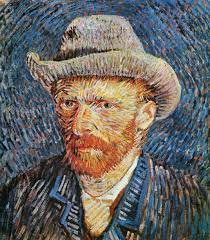“Christ alone…has affirmed eternal life as the most important certainty …”
Vincent Van Gogh
…………………………………………….
Morning Coffee with Barry Stebbing
VII. Vincent Van Gogh

Vincent Van Gogh
Why Vincent? Many believe he was not a man worth emulating. Some believe him to have been a scurrilous soul; half-crazed and a drunkard who had cut off his ear. Though there may be an element of truth to such accusations, there was so more substance and integrity within him that should be told. For his entire life he was starving for love, but never married. Extremely lonely and greatly misunderstood by both family and those around him, he was considered an outcast. In one of his letters to his brother Theo, he shared his emotional problems, “To suffer without complaining is one lesson that has to be learned.” However, Van Gogh was determined to prevail, “It will not be so easy to confound me as they think, despite all my faults. I know too well what my ultimate goal is, and I am too firmly convinced of being on the right road … to pay much attention to what people say of me.”
In studying art history, students should realize that scholars take the liberty to fill in between the lines as they so desire. With this in mind, I would now like to “read between the lines” and give you my thoughts on Vincent Van Gogh.
Vincent’s father was a minister, and as a young boy he desired to follow in his father’s footsteps. The intensity is well noted in Vincent’s early sermons, evincing a fervent passion for Christ. His church ministry was in a poor coal mining town in Belgium. Vincent chose not to live in the parsonage but, denying himself of all luxuries, chose to sleep on a bed of straw. Caring little about appearance, he even dressed in rags to be more on the level of the miners and their families. During this time he would write to Theo, “I am still far from being what I want to be, but with God’s help I shall succeed.” When the Church authorities came to visit him, they were so disappointed in his shoddy appearance and living conditions that they dismissed him. Broken hearted and rejected, Van Gogh would close his Bible and turn to painting. In a peculiar way we can see the similarities with Christ as described in Isaiah 53:2, “He has no form of comeliness; there is no beauty that we should desire Him. He is despised and rejected by men, a man of sorrows and acquainted with grief.”
Let’s take a moment and look at one of Van Gogh’s portraits (above). Like Rembrandt, he allows the viewer to go past paint and brush and have a glimpse into his soul. What I see in this painting is a man of depth, kindness, peace and sorrow.

The Sower by Vincent Van Gogh
People like to hear stories. A good speaker invariably adds a tale or two, realizing that it is an excellent way to keep the listener’s attention. Jesus was a master at this, using clear and simple stories as though speaking to a child. His stories are called parables. Simply put, parables are a wealth of truth put into layman’s terms. His desire was to lead people into the kingdom of God in a way they would understand. Paul mentions this when he said, “That they may know the simplicity of Christ.” 2Cor. 11:3
Many artists have done works expressing Jesus’s parables. One of the most popular has been the Parable of the Sower. Above is Van Gogh’s interpretation, bursting with color and powerful brush strokes, everything generated by the energetic sun.
Vincent Van Gogh spent the last ten years of his life as an artist. His little abode in Arles, France was stacked with paintings from wall to wall. Most likely his door was left unlocked as his artwork was of no value to anyone. It is said that he only sold one painting during his entire lifetime. It is hard to imagine that those paintings are now worth billions of dollars. Do you think while doing the painting of The Sower he was imagining himself as the sower, possibly thinking, “Cast your seeds upon the earth Vincent, for they will return to you after many years?” Van Gogh would go on to state that his paintings were for generations not yet born. He was right.
And so, the question rises once again, will we see Vincent Van Gogh in Heaven? It seems a surety that he had received Jesus Christ while pastoring in Belgium. And then years later, after all the pain within his short lifetime, he returned to Christ, a prodigal son coming home. And taking everything into consideration, could not the Church be at fault for not encouraging him and turning him away? To me, Van Gogh is one of the greatest tragedies and most misunderstood artists who has ever lived. My wife has often commented that the one person she would have loved to invite for dinner (save for Christ) would have been Vincent Van Gogh.
………………………………………………
Van Gogh / From one of his first sermons:
“Jesus Christ is the Master who can comfort and strengthen a man, a laborer and working man whose life is hard – because Jesus is the Great Man of Sorrows who knows our ills …”
……………………………………………………………
Coffee Memo: In the evenings, after many long days of painting in the fields, Van Gogh would light up a pipe and write to his brother, Theo. There is no mention of coffee. I wonder though, if he had a stayover with us, if we could offer him a cup of coffee in the morning, sit out on the kitchen porch and watch the morning sunlight spread across the meadows? I think he would like that very much.

